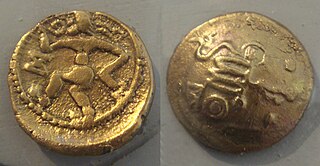
The Taurini were a Celto-Ligurian tribe dwelling in the upper valley of the river Po, around present-day Turin, during the Iron Age and the Roman period.

The Taurini were a Celto-Ligurian tribe dwelling in the upper valley of the river Po, around present-day Turin, during the Iron Age and the Roman period.
They are mentioned as Taurĩnoí (Ταυρῖνοί) by Polybius (2nd c. BC), [1] Taurini by Livy (late 1st c. BC), [2] Taurinoí (Ταυρινοί) by Strabo (early 1st c. AD), [3] Taurinorum by Pliny (1st c. AD), [4] and as Taurínōn (Ταυρίνων; var. Ταυρικῶν, Ταυρινῶν) by Ptolemy (2nd c. AD). [5] [6]
The ethnic name Taurini can be translated as 'the tribe of the bull'. [7] It is either an older form of the metathesized Celtic noun taruos ('bull'), or a non-Celtic Ligurian form. [8] [6]
The Taurini lived between the Dora Riparia and the upper Po river and the lower Dandrune river. [9] Their territory was located east of the Iemerii, west of the Libicii and Iadatini. [10]

Their original capital, Taurasia, was destroyed by the Carthaginians after they opposed in vain Hannibal's march into Italy in 218 BC. It was refounded by the Romans after 25 BC as Colonia Augusta Taurinorum (modern Turin), at the confluence of the Dora and Po. The settlement was hit by a fire in 69 AD. [9] [11]
They were involved in Rome's wars against the Celts at the end of the 4th century BC. [9]
In 218 BC, they were attacked by Hannibal, who had allied with their long-standing enemies, the Insubres. Their chief town was captured by Hannibal's forces after a three-day siege. [12]
The ethnic identity of the Taurini is unclear. They have been variously described as Celts, Ligurians, or Celticized Ligurians. [9] [11]

The Lingones were a Gallic tribe of the Iron Age and Roman periods. They dwelled in the region surrounding the present-day city of Langres, between the provinces of Gallia Lugdunensis and Gallia Belgica.
The Viducassēs were a Gallic tribe dwelling in the modern Calvados department during the Iron Age and the Roman period.
The Oxybii or Oxubii were a Celto-Ligurian tribe dwelling on the Mediterranean coast during the Iron Age and the Roman period.
The Salyes or Salluvii were an ancient Celto-Ligurian people dwelling between the Durance river and the Greek colony of Massalia during the Iron Age. Although earlier writers called them 'Ligurian', Strabo used the denomination 'Celto-ligurian' in the early 1st century AD. A Celtic influence is noticeable in their religion, which centred on the cult of the tête coupée, as well as in the names of their towns and leaders. During the 2nd century BC, the Salyes were most likely at the head of a political and military confederation that united both Gallic and Ligurian tribes.
The Medulli were a Gallic tribe dwelling in the upper valley of Maurienne, around present-day Modane (Savoie), during the Iron Age and Roman period.
The Veragrī were a Gallic tribe dwelling around present-day Martigny, in the Pennine Alps, during the Iron Age and the Roman period.
The Salassi or Salasses were a Gallic or Ligurian tribe dwelling in the upper valley of the Dora Baltea river, near present-day Aosta, Aosta Valley, during the Iron Age and the Roman period.
The Latobici or Latovici were a Celtic tribe dwelling in Pannonia Superior, around present-day Drnovo (Slovenia), during the Roman period.
The Tricastini were a small Gallic tribe dwelling in the modern Tricastin region, near present-day Saint-Paul-Trois-Châteaux, during the Iron Age and the Roman period.

The Namnetes were a Gallic tribe dwelling near the modern city of Nantes during the Iron Age and the Roman period.

The Vindelici were a Gallic people dwelling around present-day Augsburg (Bavaria) during the Iron Age and the Roman period.
The Segovellauni were a small Gallic tribe dwelling in the modern Drôme department, near the present-day city of Valence, during the Iron Age and the Roman period.
The Vediantii were a Celto-Ligurian tribe dwelling on the Mediterranean coast, near present-day Nice, during the Iron Age and the Roman period.
The Ingauni were a Celto-Ligurian tribe dwelling on the Mediterranean coast, around the modern city of Albenga (Liguria), during the Iron Age and the Roman period.
The Ambisontes were a Gallic tribe dwelling in the upper Salzach valley during the Roman period.
The Vennones or Vennonetes were a Rhaetian tribe dwelling in the northern Alps, between Chur and Lake Constance, during the Iron Age and the Roman era.
The Rucinates or Rucantii were a Gallic tribe dwelling in near the confluence of the Isar and Danube rivers during the Roman period.
The Licates were a Gallic tribe dwelling in the upper valley of the Lech river during the Iron Age and the Roman period.
The Brixentes or Brixenetes were a Celtic or Rhaetian tribe living in the Alps during the Iron Age and the Roman era.
The Libicii were a Gallic tribe dwelling in the Camargue region during the Iron Age.